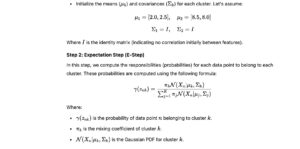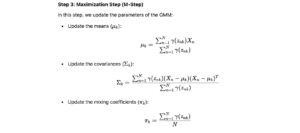Back to: Machine Learning
1. Overview of Distribution-Based Clustering Algorithms
Distribution-based clustering methods assume that the data points are generated by a mixture of different probability distributions. These algorithms attempt to identify the underlying distribution of the data and then group the data points into clusters based on these distributions.
The most popular distribution-based clustering algorithm is Gaussian Mixture Model (GMM), which models the data as a combination of multiple Gaussian distributions.
2. Gaussian Mixture Model (GMM)
Gaussian Mixture Models (GMM) are a type of distribution-based clustering that assumes the data is generated by a mixture of several Gaussian distributions, each with its own mean and variance. GMM is a probabilistic model, meaning it assigns a probability to each data point belonging to a particular cluster.
Mathematical Foundation of GMM
The goal of GMM is to find the parameters of each Gaussian distribution (mean, variance, and the mixing coefficient), so that the overall likelihood of the data given the mixture model is maximized.
- The Likelihood Function for GMM is:

3. Application of Distribution-Based Clustering (GMM)
- Customer Segmentation: GMM is used to segment customers into different groups based on purchasing behavior or preferences.
- Image Segmentation: It is used for separating regions in an image based on pixel intensity distribution.
- Anomaly Detection: By modeling data as a mixture of distributions, GMM helps in identifying anomalies as points that don’t belong to any distribution well.
- Density Estimation: GMM is used for density estimation when the goal is to estimate the underlying distribution of data.
- Speech Recognition: In speech recognition, GMM is used to model the distribution of feature vectors in different speech classes.
4. Advantages of Distribution-Based Clustering (GMM)
- Soft Assignment: Unlike K-Means, GMM allows soft assignment of data points to clusters. Each data point has a probability of belonging to each cluster, rather than being forced into a single cluster.
- Handles Elliptical Clusters: GMM can model clusters with different shapes (elliptical or elongated), unlike K-Means, which assumes spherical clusters.
- Modeling Complex Data: It is effective for data with complex distribution patterns and can accommodate varying cluster sizes and densities.
- Probabilistic Output: The model provides probabilities of membership, which is useful in many real-world applications where uncertainty needs to be quantified.
5. Disadvantages of Distribution-Based Clustering (GMM)
- Assumes Gaussian Distribution: GMM assumes that the data follows a Gaussian distribution. If the data is not Gaussian, the model may not perform well.
- Sensitive to Initialization: The model is sensitive to the initial values of the mean and covariance parameters, which can affect convergence.
- Computationally Expensive: GMM can be computationally expensive compared to other clustering methods like K-Means.
- Overfitting: If the number of clusters is chosen incorrectly, the model can overfit the data.
- Convergence Issues: In certain cases, GMM may not converge to a global optimum, especially if the number of clusters is not well-specified.
6. GMM Clustering Calculation Using Sample Data
Let’s take a simple 2D dataset to demonstrate GMM clustering. We’ll use the Expectation-Maximization (EM) algorithm to fit the Gaussian Mixture Model to the data. The EM algorithm iteratively improves the model’s parameters by estimating the responsibilities (probabilities) and updating the parameters.
Sample Data (2D)
| Point | Feature 1 | Feature 2 |
|---|---|---|
| P1 | 1.0 | 2.0 |
| P2 | 2.0 | 2.5 |
| P3 | 3.0 | 3.0 |
| P4 | 8.0 | 8.5 |
| P5 | 9.0 | 9.0 |
Step 1: Initialize Parameters
- We randomly choose 2 clusters (K=2).


Step 4: Repeat Steps 2 and 3
Iterate through the E-step and M-step until the log-likelihood function converges (or a stopping criterion is met).